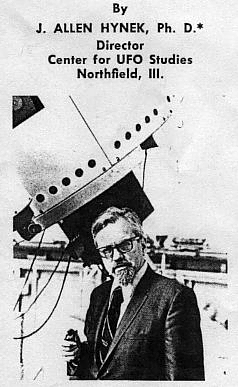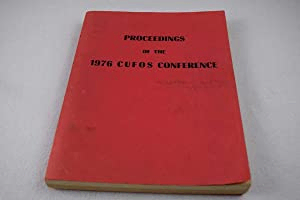
Summary
CUFOS, or the Center for UFO Studies, began in 1973 as an effort from its founder, Dr. J. Allen Hynek, to create a scientific institution devoted to investigating UAP. Under the direction of Hynek, who was perhaps the most well known scientist in the UAP field, CUFOS served as an authoritative clearinghouse to vet UAP reports and to collect and share credible findings.
Reflecting a larger shift in the culture around UAP, CUFOS turned its attention more and more towards “contactee” and abduction accounts. That move, however, put CUFOS and UAP investigation in general at a yet greater distance from established fields of science. CUFOS’ scope and activity has diminished with the larger loss of scientific interest in UAP. After Hynek’s death in 1986, CUFOS renamed itself the J. Allen Hynek Center for UFO Studies. The center continues to this day primarily as a library and resource for UAP-related research.

‘Making UFO’s respectable’
Rebutting Condon
Hynek’s impetus for creating CUFOS was, as he told New Scientist in May 1973, his long-running frustration with the “rambling,” “poorly organized” and unscientific way UAP had been investigated. More immediately, Hynek founded CUFOS as something of reaction to the Condon Committee, a US Government-backed, public-facing, two-year investigation into UAP directed by Dr. Edward U. Condon, a seminal figure in quantum physics.¹
The Condon Committee’s final report, submitted to the US Congress in November 1968 and sold to the public as a mass market paperback, chilled scientific interest in UAP with its definitive conclusion that the phenomena did not merit further study. Hynek, who was an astronomer and the principal scientific consultant to the U.S. Air Force’s UAP investigation effort, Project Blue Book and its predecessors, Projects Sign and Grudge, found the Condon Committee’s conclusion at odds with the actual findings of the report.
“The Condon report settled nothing,” Hynek said in his 1972 book, The UFO Experience: A Scientific Inquiry. Hynek insisted that “carefully read, the [Condon] report constitutes about as good an argument for the study of the UFO phenomenon as could have been made in a short time.”²
The UFO Experience, which struck a somber and factual tone on an often sensationalized topic, was a remarkable success. By May 1973, the book reached its fourth printing and helped solidify Hynek’s reputation as the lead scientific voice “making UFO’s respectable,” as New Scientist said.³
At the same time, Hynek, who was chair of the astronomy department at Northwestern University, began floating the idea of a dedicated center for scientific UAP study at Northwestern’s campus north of Chicago. According to historian Kate Dorsch, Hynek largely saw the center, which would take shape a year later as CUFOS, as balm against the damage of the Condon Committee and a long term effort to shore up the legitimacy of scientific UAP study. Affiliation with Northwestern, Hynek reasoned, would be a boon to the projects’ credibility.⁴
University administration, however, bristled at the idea. Hynek was at once a celebrated faculty member and, due to the “crackpot” associations with UAP in broader culture, an occasional embarrassment to the university. Hynek spent the better part of 1973 and ‘74 attempting to convince the administration to lend the Northwestern name to his project, assuring them that he would secure private funding, but to avail. Northwestern refused.
Founding CUFOS
Despite a lack of support from Northwestern, Hynek founded CUFOS in 1973, envisioning the project as an “invisible college” of scientists dedicated to uncovering the truth behind UAP. ⁵ To this end, Hynek organized CUFOS towards three major tasks: investigating UAP reports; supporting UAP research; and providing the best of CUFOS-vetted findings to the public.

Investigations
With regard to investigations, CUFOS set up a 24-hour toll free hotline where people could report UAP sightings without fear of ridicule.⁶ In its first year, the hotline received 443 reports, and in the following year, the Federal Bureau of Investigation began directing FBI field offices and local police departments to transfer calls from UAP witnesses directly to the CUFOS hotline. The FBI reportedly encouraged law enforcement to place CUFOS stickers with the hotline number beside switchboards.⁷ The FBI also published an article from Hynek entitled “The UFO Mystery” in the February 1975 FBI Law Enforcement Bulletin, detailing how law enforcement agencies could assist CUFOS in efficiently and thoroughly investigating sightings.⁸
(According to an internal FBI memo, renowned “debunker” Philip J. Klass called the FBI to criticize “in strong terms laced with sarcasm” the decision to run Hynek’s article. The FBI representative taking the call defended Hynek as a reputable scientist affiliated with a prestigious university, to which Klass reportedly responded, “He won’t be for long!”).⁹

Calls netted from the hotline provided cases for CUFOS’ field investigators to pass along to the organization’s “scientific board,” which Hynek described as a “loose affiliation” of academics and scientists from universities including Stanford, UCLA, University of Chicago, University of Colorado, University of Texas, University of Wisconsin, University of Utah, University of Illinois, Johns Hopkins, Yeshiva, and Northwestern.¹⁰ By 1977, CUFOS had a team of 86 trained field investigators, and by 1981, that number had risen to 128.¹¹
Unlike “big-tent” organizations such as NICAP (the National Investigations Committee on Aerial Phenomena) or MUFON (the Mutual UFO Network), both of which had thousands of members, CUFOS cast itself as a scientific, investigative cadre. Without dues from a broad membership (CUFOS restricted membership to scientists and technicians), the organization relied primarily on private donations.
Publication and research
Reputable publications were core to CUFOS’ mission. Beginning in 1976, CUFOS published The International UFO Reporter. IUR typically featured several articles on topics such as atmospheric anomalies, alleged contact with extraterrestrials, and analysis of historical sightings and data.¹² Also in 1976, CUFOS held a conference which produced 35 scholarly papers from physicists, historians, sociologists, engineers and more on topics such as aeronautics, optics, psychology, magnetics and biology.¹³

Beginning in 1977, CUFOS published Center Investigative Quarterly, a newsletter on best practices for UAP investigation and study.¹⁴ In 1979, CUFOS formalized its commitment to scholarly articles by publishing the Journal of UFO Studies, the first and only UAP-centered peer-reviewed journal.¹⁵
In 1976, Dr. David Saunders, a CUFOS member who had been a principal investigator on the Condon Committee (though he left the committee over Condon’s alleged anti-UAP bias), gave CUFOS a massive database of sighting reports that would take the name of “UFOCAT”. Saunders had cultivated the database from 1967 onward, storing information on a large IBM mainframe computer that operated with magnetic tapes. CUFOS would maintain and modernize UFOCAT over the coming decades, collecting and cataloging hundreds of thousands of UAP reports.¹⁶

The trouble with contactees
At the time of CUFOS’ founding, UAP as a cultural phenomenon was moving away from sightings of alleged objects in the sky and towards accounts of contact with extraterrestrials, including cases of alleged abduction.
This trend posed a problem for UAP study, especially those who sought to keep that study “respectable.” Whereas alleged objects in the sky might be investigated through radar readings, photography, analysis of light, aeronautics, physics, meteorology and other established fields of science and technology, accounts of alien encounters implicated the murky and unruly waters of human psychology.
Moreover, UAP sightings held open the possibility of misidentification of meteorological phenomena or human aircraft, something that could happen to anyone. In contrast, alleged contact with extraterrestrials was a decidedly extreme claim.
In other words, alien contact and abduction accounts flummoxed traditional, scientific investigation and begged association with the “crackpot fringe” of UAP culture.
CUFOS’ early success had depended largely on Hynek’s dependable reputation. He had been the U.S. Air Force’s lead UAP investigator, a best-selling author and was now the founder and public face of the most credible UAP investigation organization. This credibility led to Hynek’s behind the scenes involvement and onscreen appearance in Steven Spielberg‘s Close Encounters of the Third Kind, one of the highest grossing films of the 1970’s.¹⁷ His scientific clout also led to his role as a featured expert in the Golden-Globe nominated documentary UFO’s: Past, Present and Future.¹⁸
However, to be involved with UAP in the 1970s meant dealing with contact and abduction.
UFO’s: Past, Present and Future, for example, begins with a conventional, sightings-based history of UAP, but then moves into abduction accounts and speculation on extraterrestrial physiology. Likewise, the plot of the blockbuster Close Encounter of the Third Kind revolves around contact with extraterrestrials. The title itself comes from the taxonomy Hynek laid out in The UFO Experience; close encounters of the first kind being at about 500 feet from a UAP, and the third kind being within the presence of the entity, extraterrestrial or otherwise, controlling the UAP.
The study of UAP had moved inexorably from first to third kind. CUFOS could not avoid the association, despite resistance from Hynek.
In the August 16, 1976, issue of People magazine, when asked how he regards abduction and contactee accounts, Hynek replied, "Frankly, I quite strenuously avoid them. I'm almost embarrassed by the reports. None of those people have ever been able to produce anything reliable. It's junk, junk, junk!"¹⁹
Earlier, in October 1974, when interviewed by the journal Nature, Hynek expressed skepticism as to whether intelligent life was behind UAP. "There are too many things against it,” Hynek reportedly said. “It seems ridiculous that any intelligence would come from such great distances to do reportedly stupid things like stopping cars and frightening people. And there are far, far too many reports."²⁰
The tension between straight-laced UAP science and the troubling contactee trend manifested at CUFOS. On the one hand, the FBI had, in effect, validated CUFOS. The Library of Congress designated CUFOS as the singular, reputable authority on UAP.²¹ CUFOS published dozens upon dozens of peer-reviewed articles, maintained its massive, vetted and evolving database, and boasted a board exclusively composed of scientists, academics and technicians.
On the other hand, contactee and abduction accounts were coming through the CUFOS hotline; the first issue of IUR featured a report titled “An Abduction in Western Kansas,” a species of story that would be mainstay in future issues²²; of the 35 articles from 1976 CUFOS convention, eight dealt directly with contact and abduction, authors noting that fully half of the known cases had occurred within the last six years.²³ The authors, perhaps reflecting the precarious footing of their credibility, sounded an open minded-yet-skeptical note on the topic of hypnotic regression, which was quickly emerging as the primary tool to uncover alleged abduction accounts.²⁴
Some authors, such as Dr. Leo Sprinkle, a psychologist at the University of Wyoming, struck a pro-hypnosis stance, whereas others, such as Dr. Alvin Lawson of California State University Long Beach, argued that the method was too slippery and would lead to irredeemably confused accounts.
As in the wider UAP community, the debate over how to investigate contact and abduction accounts would persist within CUFOS for decades. Meanwhile, UAP became ever more ensconced in mysticism and the paranormal. Scientific concern waned, and CUFOS waned with it.

After Hynek
Dr. J. Allen Hynek died of cancer on April 27, 1986. Dr. Mark Rodeghier, who has training in sociology, astrophysics and computer science, took over as President and Scientific Director of CUFOS. Around the same time, the privately-funded organization downsized due to financial difficulties. A perhaps emblematic loss was that of astronomer Alan Hendry as CUFOS lead researcher. By the organization’s own account, CUFOS could no longer afford the position, and Hendry had come to the conclusion that the investigation of UAP was mired in futility.²⁵
CUFOS printed Center Investigative Quarterly until 1988, the Journal of UFO Studies until 2006 and the International UFO Reporter until 2012. CUFOS, which remains under Rodeghier’s direction, continues to offer a 2009 version of UFOCAT with approximately 210,000 UAP reports on DVD (a 47-page instruction manual is included).²⁶ CUFOS also supports UAP research with its physical collection of materials located in Chicago, Illinois, and remains open to receiving UAP reports.²⁷